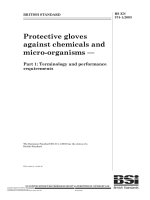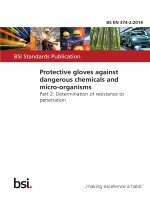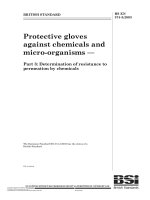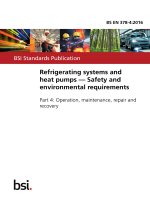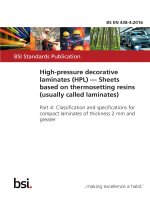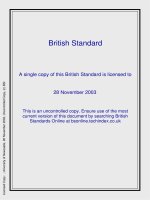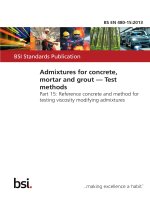Bsi bs en 00374 4 2013
Bạn đang xem bản rút gọn của tài liệu. Xem và tải ngay bản đầy đủ của tài liệu tại đây (1016.83 KB, 18 trang )
BS EN 374-4:2013
BSI Standards Publication
Protective gloves against
chemicals and micro-organisms
Part 4: Determination of resistance to
degradation by chemicals
BS EN 374-4:2013
BRITISH STANDARD
National foreword
This British Standard is the UK implementation of EN 374-4:2013.
The UK participation in its preparation was entrusted to Technical
Committee PH/3/8, Protective gloves.
A list of organizations represented on this committee can be
obtained on request to its secretary.
This publication does not purport to include all the necessary
provisions of a contract. Users are responsible for its correct
application.
© The British Standards Institution 2013. Published by BSI Standards
Limited 2013
ISBN 978 0 580 77775 2
ICS 13.340.40
Compliance with a British Standard cannot confer immunity from
legal obligations.
This British Standard was published under the authority of the
Standards Policy and Strategy Committee on 30 November 2013.
Amendments issued since publication
Date
Text affected
BS EN 374-4:2013
EN 374-4
EUROPEAN STANDARD
NORME EUROPÉENNE
EUROPÄISCHE NORM
November 2013
ICS 13.340.40
English Version
Protective gloves against chemicals and micro-organisms - Part
4: Determination of resistance to degradation by chemicals
Gants de protection contre les produits chimiques et les
micro-organismes - Partie 4: Détermination de la résistance
à la dégradation par des produits chimiques
Schutzhandschuhe gegen Chemikalien und
Mikroorganismen - Teil 4: Bestimmung des Widerstandes
gegen Degradation durch Chemikalien
This European Standard was approved by CEN on 28 September 2013.
CEN members are bound to comply with the CEN/CENELEC Internal Regulations which stipulate the conditions for giving this European
Standard the status of a national standard without any alteration. Up-to-date lists and bibliographical references concerning such national
standards may be obtained on application to the CEN-CENELEC Management Centre or to any CEN member.
This European Standard exists in three official versions (English, French, German). A version in any other language made by translation
under the responsibility of a CEN member into its own language and notified to the CEN-CENELEC Management Centre has the same
status as the official versions.
CEN members are the national standards bodies of Austria, Belgium, Bulgaria, Croatia, Cyprus, Czech Republic, Denmark, Estonia,
Finland, Former Yugoslav Republic of Macedonia, France, Germany, Greece, Hungary, Iceland, Ireland, Italy, Latvia, Lithuania,
Luxembourg, Malta, Netherlands, Norway, Poland, Portugal, Romania, Slovakia, Slovenia, Spain, Sweden, Switzerland, Turkey and United
Kingdom.
EUROPEAN COMMITTEE FOR STANDARDIZATION
COMITÉ EUROPÉEN DE NORMALISATION
EUROPÄISCHES KOMITEE FÜR NORMUNG
CEN-CENELEC Management Centre: Avenue Marnix 17, B-1000 Brussels
© 2013 CEN
All rights of exploitation in any form and by any means reserved
worldwide for CEN national Members.
Ref. No. EN 374-4:2013 E
BS EN 374-4:2013
EN 374-4:2013 (E)
Contents
Page
Foreword ..............................................................................................................................................................3
1
Scope ......................................................................................................................................................4
2
Normative references ............................................................................................................................4
3
Terms and definitions ...........................................................................................................................4
4
Test principles........................................................................................................................................4
5
Test methods, Puncture resistance test .............................................................................................4
5.1
Sampling .................................................................................................................................................4
5.2
Apparatus ...............................................................................................................................................5
5.3
Procedure ...............................................................................................................................................5
5.3.1
Test conditions ......................................................................................................................................5
5.3.2
Pre-testing measurements ....................................................................................................................5
5.3.3
Puncture testing.....................................................................................................................................6
5.3.4
Expression of results ............................................................................................................................7
6
Test report ..............................................................................................................................................7
Annex A (informative) Inter laboratory test on the present test method .......................................................9
Annex B (informative) Weight change test .................................................................................................... 10
B.1
General ................................................................................................................................................. 10
B.2
Sampling .............................................................................................................................................. 10
B.3
Apparatus ............................................................................................................................................ 10
B.4
Procedure ............................................................................................................................................ 10
B.4.1
Measurements ..................................................................................................................................... 10
B.4.2
Test conditions ................................................................................................................................... 10
B.4.3
Procedure ............................................................................................................................................ 10
B.4.4
Calculation ........................................................................................................................................... 11
B.4.5
Expression of results ......................................................................................................................... 11
B.5
Test report ........................................................................................................................................... 11
Annex ZA (informative)
Relationship between this European Standard and the Essential
Requirements of EU Directive 89/686/EEC ....................................................................................... 13
2
BS EN 374-4:2013
EN 374-4:2013 (E)
Foreword
This document (EN 374-4:2013) has been prepared by Technical Committee CEN/TC 162 “Protective clothing
including hand and arm protection and lifejackets”, the secretariat of which is held by DIN.
This European Standard shall be given the status of a national standard, either by publication of an identical
text or by endorsement, at the latest by May 2014 and conflicting national standards shall be withdrawn at the
latest by May 2014.
Attention is drawn to the possibility that some of the elements of this document may be the subject of patent
rights. CEN [and/or CENELEC] shall not be held responsible for identifying any or all such patent rights.
This document has been prepared under a mandate given to CEN by the European Commission and the European Free Trade Association, and supports essential requirements of EU Directive(s).
For relationship with EU Directive(s), see informative Annex ZA, which is an integral part of this document.
EN 374 consists of the following parts under the general title, Protective gloves against chemicals and microorganisms:
—
Part 1: Terminology and performance requirements;
—
Part 2: Determination of resistance to penetration;
—
Part 3: Determination of resistance to permeation by chemicals;
—
Part 4: Determination of resistance to degradation by chemicals.
According to the CEN-CENELEC Internal Regulations, the national standards organizations of the following
countries are bound to implement this European Standard: Austria, Belgium, Bulgaria, Croatia, Cyprus, Czech
Republic, Denmark, Estonia, Finland, Former Yugoslav Republic of Macedonia, France, Germany, Greece,
Hungary, Iceland, Ireland, Italy, Latvia, Lithuania, Luxembourg, Malta, Netherlands, Norway, Poland, Portugal,
Romania, Slovakia, Slovenia, Spain, Sweden, Switzerland, Turkey and the United Kingdom.
3
BS EN 374-4:2013
EN 374-4:2013 (E)
1
Scope
This European Standard specifies the test method for the determination of the resistance of protective glove
materials to degradation by dangerous chemicals with continuous contact.
NOTE
Annex A gives information on interlaboratory test results on this method.
Other tests used to evaluate chemical resistance such as permeation resistance and penetration resistance
may not provide sufficient information on the physical property changes affecting a glove during exposure to a
chemical. It is necessary that the outside surface of the glove be exposed to the chemical.
2
Normative references
The following documents, in whole or in part, are normatively referenced in this document and are
indispensable for its application. For dated references, only the edition cited applies. For undated references,
the latest edition of the referenced document (including any amendments) applies.
EN 374-1:2003, Protective gloves against chemicals and micro-organisms - Part 1: Terminology and performance requirements
EN 388:2003, Protective gloves against mechanical risks
EN 420:2003+A1:2009, Protective gloves - General requirements and test methods
3
Terms and definitions
For the purposes of this
EN 420:2003+A1:2009 apply.
4
document,
the
terms
and
definition
given
in
EN 374-1:2003
and
Test principles
The resistance of a protective glove material to degradation by a liquid chemical is determined by measuring
the puncture resistance change of the glove material after a continuous contact with the external surface with
the challenge test chemical. The test is applicable to gloves made of natural or synthetic polymer. Lined
gloves may produce unusable measurement results.
5
Test methods, Puncture resistance test
5.1 Sampling
Select three gloves for testing. Condition the gloves at (23 ± 2) °C, (50 ± 5) % relative humidity for at least
24 hours.
In the case of irregular and/or multiple construction, one sample shall be tested from each area. Using the
appropriate circular die of 20 mm, cut 6 specimens of each glove for a total of 18 test specimens. For each
glove, 3 specimens will be exposed to the challenge chemical and 3 specimens will be unexposed.
Select specimens so that they are homogeneous and representative of the glove’s primary construction. Avoid
embossed patterned areas or other areas of varying thickness or composition when cutting these specimens.
If a glove is constituted of several unbounded layers, only the layer giving the chemical protection shall be
tested.
The sample shall be tested according to the method described in 5.3. An additional non-mandatory
informative test method is given as an example in Annex B.
4
BS EN 374-4:2013
EN 374-4:2013 (E)
For lined gloves, if it is not possible to separate the liner from the glove (and if the liner is too thick), the test
may not be feasible, because it is not possible to seal the vial and the sample is moving. For certain samples,
if there is a thick liner, it may not be necessary to use the septa to have a correct vial sealing. In this case, the
liner will ensure the leakproofness.
5.2 Apparatus
The following equipment shall be used:
a)
(20 ± 1) mm diameter cutting die;
b)
(12 ± 1) mm diameter cutting die (for cutting a hole to the centre of each septum);
c)
20 ml crimp top vials (opening (12,5 ± 0,5) mm of diameter);
d)
20 mm diameter septa (e.g. made from chlorobutyl rubber without polytetrafluoroethylene (PTFE) layer);
e)
20 mm open centre aluminium crimp seals;
f)
hand crimper;
g)
hand decapper;
h)
samples holder with 18 holes of 20 mm diameter;
i)
150 ml beaker;
j)
transfer pipette, 2 ml;
k)
dynamometer with a puncture stylus according to EN 388:2003, 6.4 and a cell to measure compression
forces with a precision of ± 1 %;
l)
sample vial support.
5.3 Procedure
5.3.1 Test conditions
The test shall be conducted at (23 ± 2) °C (preparation, chemical, time exposure to chemical, puncture test).
5.3.2 Pre-testing measurements
Place the challenge chemical into the 150 ml beaker. Using the transfer pipette, place about 2 ml of challenge
chemical into one of the crimp top vials.
Seat a septum in an open centre aluminium crimp seal cap. Using the (12 ± 1) mm cutting die, make a centred
hole in the septum.
Place a glove specimen on top of the septum with its normal external surface facing towards the interior of the
vial. Place the aluminium cap with the sample on top of the vial. Seal the vial using the hand crimper and
invert it so that the challenge chemical is in contact with the specimen (see Figure 1). Record the time. Place
the vial in the punched-out sample holder.
NOTE
The punched-out sample holder has a twofold purpose. 1) It allows air to circulate under the sample film, and
2) if the pressure from the challenge chemical forces the sample into a convex shape, the flask will still stand.
5
BS EN 374-4:2013
EN 374-4:2013 (E)
Repeat the procedure in the above paragraph for each of the remaining eight specimens that are to be
exposed. Time these actions so that the exposures on succeeding specimens begin at three-minute intervals.
At the end of the one-hour exposure period (±5 min), examine each test vial to confirm coverage of the
specimen with the challenge chemical. If the chemical is not covering the specimen, discard the specimen and
repeat the test using a larger quantity of challenge chemical.
Mount the nine unexposed specimens in the remaining vials in the same manner, except that no chemical is
placed in the vial.
Key
1
challenge chemical
2
outer surface of the glove sample which is in contact with the challenge chemical,
it is a circular area of (12,5 ± 0,5) mm diameter
Figure 1 — Position of the vial during contact time between the sample and the dangerous chemical
Key
1
20 ml crimp vial
2
puncture stylus
3
sample
4
vial carrier (to be maintain by the dynamometre jaw)
Figure 2 — Position of the vial during puncture test
5.3.3 Puncture testing
Install the puncture stylus on the dynamometer load cell. Set the carriage speed to 100 mm/min and screw the
vial support onto the table.
Place a vial into the support. Puncture the specimen and record the peak force required (see Figure 2).
6
BS EN 374-4:2013
EN 374-4:2013 (E)
Repeat for each of the specimens; test each of the exposed specimens one hour after the exposure on that
specimen was started.
Test specimens shall be examined for any changes to their physical properties during and after the test (after
drying). Any changes such as swelling, shrinking, brittleness, hardening, softening, flaking, disintegration,
colour change/bleeding, delaminating shall be noted and described on the test report for information.
5.3.4 Expression of results
Determine the degradation for each of the three glove specimens against each specific chemical or chemical
mixture using the formula:
DRx =
(OPx - RPx)
X 100
OPx
(1)
where
DRx
is the degradation of the x glove specimen against challenge chemical tested, in %;
OPx
is the average puncture force on the three unexposed test specimens from the x glove
specimen; units shall be same as RPx;
RPx
is the average puncture force on the three exposed test specimens from the x glove specimen;
units shall be same as OPx .
Determine the degradation of the sample against the challenge chemical using the following Formula (2):
DR =
(DR1 + DR2 + DR3 )
3
(2)
where
DR
is the degradation of the test sample against challenge chemical tested, in %;
DR1
is the degradation of the first glove specimen against challenge chemical tested, in %;
DR2
is the degradation of the second glove specimen against challenge chemical tested, in %;
DR3
is the degradation of the third glove specimen against challenge chemical tested, in %.
Determine the standard deviation (SD) of the degradation for the three gloves.
6
Test report
For each protective glove material tested, a report shall include the following information:
a)
Report the manufacturer’s reference for the glove tested including the material, style, and lot number.
b)
Report the name of the test chemical, its purity, and if it is in a mixture, its concentration and other
components.
c)
Make reference to this European Standard.
d)
Report the date of the test.
7
BS EN 374-4:2013
EN 374-4:2013 (E)
e)
Report DR1, DR2, DR3, DR (see 5.3.4), the percent change in the puncture for the glove material. The
SD shall also be reported.
f)
Report whether the liner, if present, has been separated from the test specimen.
g)
Report any observations of changes in the physical appearance of the material specimens following
chemical exposure. Examples of reported observations are swelling, shrinking, brittleness, hardening,
softening, flaking, disintegration, colour change/bleeding and delaminating.
h)
Any deviation to this European Standard shall be reported.
8
BS EN 374-4:2013
EN 374-4:2013 (E)
Annex A
(informative)
Inter laboratory test on the present test method
The following degradation data have been obtained in a collaborative correlation trial on by several
laboratories, using the test method described in Clause 5.
Table A.1 — Results in % of correlation trial with natural rubber gloves (thickness 0,6 mm)
Laboratory
Ethyl acetate
Heptane
Mean value
Standard
deviation
Mean value
Standard
deviation
1
43
6,8
66
4,0
2
37
10
61
7,0
3
36
5,9
47
1,6
4
39
4,5
49
2,8
5
40
5,3
56
6,1
6
32
2,8
51
8,1
7
-
-
56
2,4
Mean value
37,8
5,9
55,1
4,6
Table A.2 — Results in % of correlation trial with other gloves materials
Laboratory
Acetone
Mean
value
glove in
Nitrile
Sulfuric acid
Mean
value
glove in
PVC
Mean value
glove in
Polychloroprene
Mean value
glove in
Nitrile
Mean value
glove in
PVC
Mean value
glove in
Polychloroprene
1
85
90
65
49
−36
3
2
89
86
63
57
−55
6
3
88
98
60
46
−50
−6
4
86
89
60
57
−41
5
5
92
87
-
40
−31
-
6
-
-
-
62
-
13
9
BS EN 374-4:2013
EN 374-4:2013 (E)
Annex B
(informative)
Weight change test
B.1 General
This method is only dedicated to material assessment and does not take into account the actual use of a
personal protective equipment (PPE).This annex describes another test method for the determination of the
resistance of materials to degradation by dangerous chemicals with continuous contact by a weight change
test.
B.2 Sampling
The glove shall be conditioned at (23 ± 2) °C for at least 24 h. The specimens shall be taken from three
gloves. Put the glove flat on a surface and measure (60 ± 2) mm from fingertip. The specimens shall consist of
a cut off of the same finger of each glove.
B.3 Apparatus
B.3.1
Analytical balance, accurate to 0,001 g, used to determine weight.
B.3.2
Beakers, e.g. a 50 ml glass beaker or other container (depth of at least 5,1 cm).
B.3.3
Time measuring device, a stopwatch or other timing devices.
B.3.4
Test tube with a weight, or other device to hold specimen upright in beaker.
B.3.5
Covered weighing dish, for holding specimens during weighing.
B.4 Procedure
B.4.1 Measurements
Measure the original weight of each finger specimen to the nearest 0,001 g.
B.4.2 Test conditions
The test shall be conducted at (23 ± 2) °C (preparation, chemical, time exposure to chemical).
B.4.3 Procedure
Start the timer and immerse the finger specimen in a beaker containing the test chemical. The weighed test
tube will hold the specimen upright in the beaker. The beaker should be filled to a depth of (42 ± 2) mm with
the test chemical (Figure B.1). The quantity of the test chemical shall be adapted during the test to keep the
beaker filled to the marking. Multiple finger specimens may be started at approximately one minute timed
intervals to allow for weighing of the specimens.
10
BS EN 374-4:2013
EN 374-4:2013 (E)
Dimensions in millimetres
Figure B.1 — Typical arrangement of weight gain test apparatus
After 60 min (±5 min) of exposure, remove the finger specimen from the chemical, lightly blot dry to remove
surface liquid with a clean towel, place in a covered weighing dish, and record the specimen weight to an
accuracy to the nearest 0,001 g. The weighing of the finger cut shall be carried out as quickly as possible after
60 min exposure.
Finger specimens shall be examined for any changes to their physical properties during and after the test
(after drying). Any changes such as swelling, shrinking, brittleness, hardening, softening, flaking,
disintegration, colour change/bleeding, delaminating shall be noted and described on the test report.
B.4.4 Calculation
Calculate the percent weight change based on the initial weight. The weight change may be positive
(increase) or negative (decrease). Calculate the change in weight between the original specimen and the
specimen weight after 60 min of exposure. Divide this difference by the original weight and multiply by 100 to
obtain the percent weight change.
Determine an average of the percent weight change for the three test specimens. Also determine the standard
deviation (SD) of the percent weight change for the three test specimens.
B.4.5 Expression of results
The weight change results and SD are expressed in percent.
B.5 Test report
For each protective glove material tested, a report shall include the following information:
a)
Report the manufacturer’s reference for the glove tested including the material, style, and lot number.
b)
Report the name of the test chemical, and if it is in a mixture, its concentration and other components.
c)
Make reference to this European Standard.
d)
Report the percent change in weight for each specimen and the average value and SD.
e)
Report the date of the test.
11
BS EN 374-4:2013
EN 374-4:2013 (E)
f)
Report any observations of changes in the physical appearance of the material specimens following
chemical exposure. Examples of reported observations are swelling, shrinking, brittleness, hardening,
softening, flaking, disintegration, colour change/bleeding and delaminating.
g)
Any deviation to the standard shall be reported.
12
BS EN 374-4:2013
EN 374-4:2013 (E)
Annex ZA
(informative)
Relationship between this European Standard and the Essential
Requirements of EU Directive 89/686/EEC
This European Standard has been prepared under a mandate given to CEN by the European Commission
and the European Free Trade Association to provide a means of conforming to Essential Requirements of the
New Approach Directive 89/686/EEC on the approximation of the laws of the Member States relating to
personal protective equipment.
Once this standard is cited in the Official Journal of the European Union under that Directive and has been
implemented as a national standard in at least one Member State, compliance with the clauses of this
standard, together with the relevant requirements given in the product standards, confers within the limits of
the scope of those standards, a presumption of conformity with the Essential Requirement 1.3.2 of Annex II of
that Directive and associated EFTA regulations.
WARNING — Other requirements and other EU Directives may be applicable to the product(s) falling within
the scope of this standard.
13
This page deliberately left blank
This page deliberately left blank
NO COPYING WITHOUT BSI PERMISSION EXCEPT AS PERMITTED BY COPYRIGHT LAW
British Standards Institution (BSI)
BSI is the national body responsible for preparing British Standards and other
standards-related publications, information and services.
BSI is incorporated by Royal Charter. British Standards and other standardization
products are published by BSI Standards Limited.
About us
Revisions
We bring together business, industry, government, consumers, innovators
and others to shape their combined experience and expertise into standards
-based solutions.
Our British Standards and other publications are updated by amendment or revision.
The knowledge embodied in our standards has been carefully assembled in
a dependable format and refined through our open consultation process.
Organizations of all sizes and across all sectors choose standards to help
them achieve their goals.
Information on standards
We can provide you with the knowledge that your organization needs
to succeed. Find out more about British Standards by visiting our website at
bsigroup.com/standards or contacting our Customer Services team or
Knowledge Centre.
Buying standards
You can buy and download PDF versions of BSI publications, including British
and adopted European and international standards, through our website at
bsigroup.com/shop, where hard copies can also be purchased.
If you need international and foreign standards from other Standards Development
Organizations, hard copies can be ordered from our Customer Services team.
Subscriptions
Our range of subscription services are designed to make using standards
easier for you. For further information on our subscription products go to
bsigroup.com/subscriptions.
With British Standards Online (BSOL) you’ll have instant access to over 55,000
British and adopted European and international standards from your desktop.
It’s available 24/7 and is refreshed daily so you’ll always be up to date.
You can keep in touch with standards developments and receive substantial
discounts on the purchase price of standards, both in single copy and subscription
format, by becoming a BSI Subscribing Member.
PLUS is an updating service exclusive to BSI Subscribing Members. You will
automatically receive the latest hard copy of your standards when they’re
revised or replaced.
To find out more about becoming a BSI Subscribing Member and the benefits
of membership, please visit bsigroup.com/shop.
With a Multi-User Network Licence (MUNL) you are able to host standards
publications on your intranet. Licences can cover as few or as many users as you
wish. With updates supplied as soon as they’re available, you can be sure your
documentation is current. For further information, email
BSI Group Headquarters
389 Chiswick High Road London W4 4AL UK
We continually improve the quality of our products and services to benefit your
business. If you find an inaccuracy or ambiguity within a British Standard or other
BSI publication please inform the Knowledge Centre.
Copyright
All the data, software and documentation set out in all British Standards and
other BSI publications are the property of and copyrighted by BSI, or some person
or entity that owns copyright in the information used (such as the international
standardization bodies) and has formally licensed such information to BSI for
commercial publication and use. Except as permitted under the Copyright, Designs
and Patents Act 1988 no extract may be reproduced, stored in a retrieval system
or transmitted in any form or by any means – electronic, photocopying, recording
or otherwise – without prior written permission from BSI. Details and advice can
be obtained from the Copyright & Licensing Department.
Useful Contacts:
Customer Services
Tel: +44 845 086 9001
Email (orders):
Email (enquiries):
Subscriptions
Tel: +44 845 086 9001
Email:
Knowledge Centre
Tel: +44 20 8996 7004
Email:
Copyright & Licensing
Tel: +44 20 8996 7070
Email:
